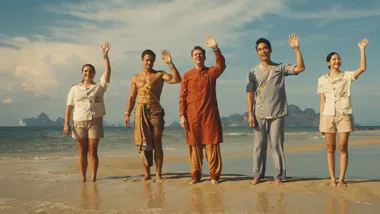There are 538 very uneven, steep and slippery stone steps to climb before I reach the Kamikura-Jinja Shrine. But once I get to the top, I will be at one of the oldest and most sacred places in the Kii Peninsula.
I am around 500km south of Tokyo and a four-hour scenic drive from Nara, deep in the forested heartland of Japan’s Kumano Kodo pilgrimage route.
The view of the sweeping valley below is breathtaking and as I explore the small shrine, which is tucked under a massive boulder, I can understand why this place is so spiritually significant.
This is the location where, it’s believed, the Shinto gods first descended from above. This is also where the famous Oto Matsuri festival takes place every February, when around 2000 men holding lit torches run down the stone steps in an ancient traditional fire ritual, and pray for the wellbeing of their families.

ENLIGHTENMENT AND TIKTOK
Grand physical gestures are a big part of the esoteric Buddhism, which came to this area from China around 1200 years ago. A few days in my week-long trip, I visit Kinpusen-ji Temple where
I meet a senior monk from this branch of “mountain” Buddhism.
He is in his 60s and still leads workshops that stress physical and mental endurance – activities like hanging off cliffs or sitting under waterfalls for hours at a time!
I’m not given the chance to attempt any of these, but luckily there are plenty of other entry-level paths to enlightenment available.
My favourite is strolling through awe-inspiring mountain forests of sky-high cedar trees as I do my own shortened version of the centuries-old Kumano Kodo trail.
But this is Japan, so the modern day world is always creeping into the ancient one. As I walk along the stone path, I spot a figure in red posing for photos. Closer up I see they’re wearing traditional costume and a veil and the photographer explains they’re filming clips for TikTok.

STAY AT A TEMPLE
I travel on to Koyasan, a small town also known as Mount Koya, which is a sacred mountain 90km south of Osaka and where the monk Great Master Kukai is enshrined in eternal meditation at Okunoin temple.
There are around 50 different temples here that offer overnight stays – called a Shukubo experience. I stay at one called Rengejo-in where visitors can join its monks in morning sutra reading or prayers, eat traditional vegan Buddhist meals or gaze in peaceful meditation at the karesansui-style rock garden.
The next morning it’s time to take the Okunion Sando walk to Okunoin temple. I pass through a beautiful forest and hundreds of moss-covered gravestones and shrines, as well as little Jizo statues, which are said to have spiritual power for protection and longevity.

OMENS AND ONSENS
When the guide warns me that tripping up on a certain section will lead to bad luck, I slow down and take extra care. Further along the path, I’m offered the chance to look into water inside a well, which will apparently tell me if I’m going to die in the next few years.
Soon after I’m shown to a very large, heavy stone and told that if I can lift it with one hand then my soul is light. I decline the first and fail at the second.
The area is famous for its historic, mineral-rich hot springs and a long day’s hiking is traditionally followed by an onsen to soothe aching, tired limbs.
They are usually communal, although single sex, but I get to enjoy in-room onsens at two of the hotels I stay at – on the terrace of my room at the Kamenoi hotel overlooking the ocean and at Nara’s Shisui luxury collection hotel, which is so heavenly I never want to leave.

But my most authentic onsen experience is high up in the mountain town of Yoshino at the Yoshinosou Yukawaya inn. After a night spent on my surprisingly comfortable three-layer futon, rolled out onto the tatami matting floor, I start the day in its scalding hot communal onsen, which looks over the valley.
As birds duck and fly above me and the sun rises up over the mountain peaks ahead, this is probably the most spiritual moment of my entire trip.
The Kii Peninsula is accessible from Kansai and Nanki-Shirahama airports, or Nara station and Iseshi station if you’re taking the train from Tokyo.
SPIRITUAL SIGNIFICANCE
The Kii peninsula is home to some of the country’s most important spiritual sites, including the Three Grand Shrines of Kumano and Mount Koya, and pilgrims and tourists travel between them, visiting Shinto shrines and Buddhist temples on their journey.
DON’T MISS
- The famous 133-metre Nachi waterfalls.
- Asuka town – visit the ruins of its ancient palaces.
- Visit the huge zen garden at Kongobu-ji Temple.
- Try some of the region’s Goma dofu, which is like tofu but made with sesame seeds.
HEADING TO JAPAN?
Planning your visit
From Mt Fuji to the extravagant shrine of Toshu-gu Lonely Planet’s bestselling guide is the perfect starting point for planning your journey.
Grab a copy from:
- Amazon Australia for $29.95
- Dymocks for $39.95
Accommodation
There are plenty of incredible places to choose from. Explore hotels and local stays to find somewhere in every area across the country.









